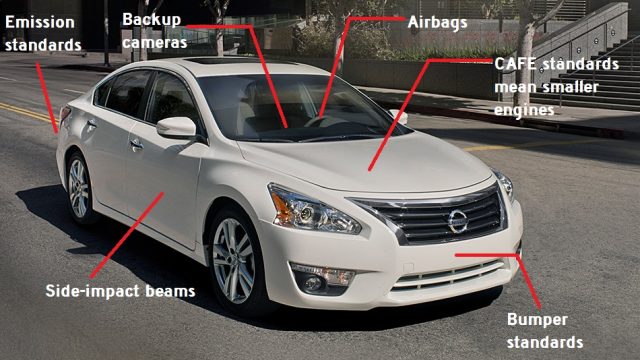Federal government wages regulatory war on the automobile

INTERFERENCE: Think of all of the federal regulations that govern the car you drive, like this Nissan Altima.
By Steve Wilson | Mississippi Watchdog
When I was a kid, I always loved cars.
My grandfather, who was a World War II veteran, was a Chevrolet man with no tolerance for anything else, especially not foreign. When my parents purchased an anemic, clattering Volkswagen Jetta diesel back in the early 1980s, he got a kick out of me calling it “The German Hunk of Junk.”
I waited breathlessly for the newest issues of the car magazines to hit the rack. I always wanted to see if the Camaro could outrun the Mustang in the quarter-mile or read about the newest Porsche. I had a poster of a 911 in my room.
Above all, the automobile was all about freedom. All I could think about as a boy was having a car and the freedom to go wherever caprice took me. I loved the sound of a revving motor and feel of a steering wheel that fed back every motion of the wheels back to your hands. The feeling of man and machine becoming one entity.
As free-market advocates, we can talk about all of the effects of government and its distortion of the free market. But there’s one of the biggest embodiments of built-up government interference sitting in your garage or driveway. There isn’t a part of your car free from the federal government’s heavy-handed regulatory morass.
The onerous CAFE (corporate average fuel economy standards) imposed in the 1970s are now getting even more intrusive. The Obama administration’s goal of 54.5 miles per gallon fleet average imposed in 2012 will result in price increases of $3,000 to $4,800 per car, according to the National Highway Safety Administration.
Thanks to states with even more nonsensical automotive regulations, like California, the auto companies went along with the CAFE proposal without a fight. Better to deal with one set of onerous regulations than five or six. Now, smaller turbo-charged engines are entering the market for fuel economy reasons rather than more reliable, bigger engines. A turbo is an air pump powered by hot exhaust gas that pushes more air into the engine, thus giving a small engine the power of a much bigger one. They used to be rare because of their complexity and expense, but now they’re everywhere, even in big trucks like the Ford F-150.
The government hits consumers who want less fuel-efficient vehicles with a “guzzler tax.” It alternatively rewards those who want to drive the hair shirts of the auto world — lethargic, plug-in hybrids like the Toyota Prius or joyless electric cars like the Nissan Leaf — with a tax credit.
For those with the cash to afford it, hyper-fast Porsche 918s (0-60 mph in 2.2 seconds that costs more than $847,000) and luxurious Teslas that cost more than $70,000 can also receive a tax credit.
The government even spent $3 billion on the “Cash for Clunkers” program in 2009, where consumers traded in their gas-guzzling older vehicles and received a credit up to $4,500 on the purchase of a more efficient new car. The old cars were scrapped and their engines purposely destroyed so no salvage could take place, depriving the used car market of 690,000 vehicles.
Of course, used car prices skyrocketed.
Once upon a time, cars were lucky to have seat belts and there were minimal regulations into crash standards. Thanks to Ralph Nader’s book about the lack of safety features in cars sold in the United States, “Unsafe At Any Speed,” the federal government got into the auto safety business in a big way.
Among the safety devices that are now mandatory are side-impact beams, electronic stability systems and airbags. All of these things add weight, which runs counter current to the goal of making the nation’s fleet of cars more fuel-efficient.
Another safety device the wizards on the Potomac have mandated is the backup camera. Usually an option on more expensive vehicles, the new mandate will become standard by 2018. It’ll add anywhere from $132 to $142 to the price of a new car. While that isn’t a huge amount of money, all of these “common sense” mandates add up and the costs are passed on to consumers in the former of higher prices.
Like everything with Leviathan, the meaning of common sense gets stretched endlessly in the quest for a perfect utopia where cars get 50 miles to the gallon and have the crash resistance of a Humvee slathered in armor plating. Consumers would likely flock to a car with more safety features — notice the importance of Insurance Institute for Highway Safety ratings — or better fuel economy when gas prices skyrocket without a labyrinth of inane regulations hatched by government bureaucrats in D.C.
Let the consumer decide. To paraphrase singer Billy Ocean, I’d like the government to get out of my dreams and out of my car as well.
Get regular updates on Mississippi through our Facebook or Twitter accounts







